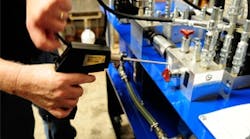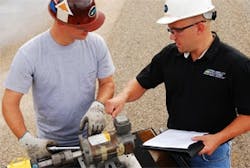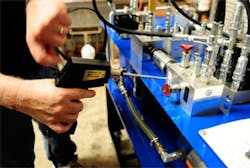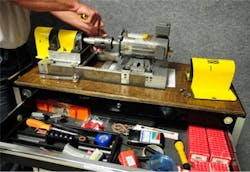Ian McKinnon is a pioneer in the precision maintenance field, a passionate instructor, and a founding principal of Reliability Solutions (www.reliabilitysolutions.net). He recently spoke with Plant Services about the role that precision maintenance can play in driving effective plantwide reliability initiatives, as well as the role of hard skills training in higher education.
Plant Services: How do you define precision maintenance, and what is its value to the average plant?
Ian McKinnon: Precision maintenance is an approach of how work is identified or determined; planned for an improved state; executed with discipline, precision, and control; and audited for reliability. Within the maintenance world, the assembly and installation of machinery are where we can have an immediate impact, and it begins with the question, "What failures do you wish to control?"
The work is not only about the assembly, installation and repair of machinery, but also about how machines that are not failing can be improved before entering the failure cycle. Precision maintenance also carries on after the work is completed: it includes a measurement of how the machine is performing post-work to identify what improvements were achieved dynamically. The improvement results are audited over time to identify where the same actions can be applied on other types of machines.
[pullquote]
Finally, precision maintenance can alter the performance of machines and manufacturing performance in the most positive sense. We begin to reduce the problems typically witnessed and associated with early equipment failure and mediocre performance if the way that we assemble, and then install all assets is:
- Incrementally controlled (with knowledge in experience),
- Sequentially applied with discipline to known and proven standards,
- Always performed in the most precise manner possible,
- Documented to maintain a correct history of exactly what improvements were performed, and
- Audited with dynamic condition measurements.
Over the last couple of decades there have been many improvements made on everyone’s operating and maintenance floors, but universally we continue to be faced with some pretty big challenges. I've watched the erosion, first of all, of skill sets, but I've also watched the erosion of people who perform training. As an example, we see few shop classes in high schools (I think we’re too afraid that someone might get hurt so we fail to introduce these young budding minds to working with their hands and minds).
It is obvious that if we are going to improve reliability within our manufacturing workforce, we need to begin to encourage the development of “hands-on hard skills” activities before we release these young folks into the college, university, technical school, and working world. I think one of the things that makes Reliability Solutions rather unique is that our real goal is the transfer of hard skills – real, practical information. I'm from the trades background, and my business partner is also from the trades background. Even before we started Reliability Solutions, it became clear from the audience that I was working with in industrial manufacturing (and this includes operations as well as maintenance) is that people learn by doing, and applying.
At RS we are not going to do training until we know where you hurt, because, once we know where you hurt, we're going to provide systems and dynamic models that replicate what happens on the field. It may not look like the machine that they are working on, but it replicates it in exactly the same way. With our approach there is the excitement of discovery – "Oh, I can do that skill" and "Oh, it matters" – but the third one is the clincher, and that is where participants look at each other in the class and say, "We've got to apply this."
More important is that when they do something, if they can measure it dynamically, by any means, or maybe multiple means, then that causes the participants in that training to understand first-hand, gut-level, what is the value of that work. The excitement of discovery not only is in obtaining that value, the discovery was, "I can do this, I can do it well, and I can put it to work right here."
Also, whatever class we teach, we always use instrumentation on the devices or systems where the participants measure their results. It's a double-sided audit where we come back in, we review the work, so they know where their success is and we can still say, "OK, we still have to tweak this." We come from the field and that means we have a direct connectivity (with the participants), and I see that as being a very high priority for us.
{pb}
PS: Have you measured or estimated the average time that your approach to precision maintenance adds between machine commissioning and the first major failure?
IM: Precision maintenance has to be applied within a reliability initiative. If you really want to convince somebody about the value of precision maintenance, then you have to come back and say, what are the things that matter. We usually start by convincing people on four real, practical deliverables that impact the bottom line:
- What is your reliability and OEE?
- What is your cost of maintenance? (In many facilities today, maintenance with the cost of labor consumes better than 50 percent of profit, and any savings there are a huge bang for your buck.)
- What is the impact on production and what skills sets do they need to improve production excellence? If you don't perform maintenance precisely and correctly, production suffers.
- What is the impact on energy consumption with the maintenance methods you're currently applying?
Our results, and we have scads of data to back these up, is that the historical performance change is that the machine life is doubled at a minimum. I don't care if the machine you worked on was 50 years old or you bought it last week. For example, we have data from 336 machines of one manufacturer, style or type with varying horsepower where we applied our approach. The historical run time between repairs for those units was somewhere between 2.8 and 3.2 years. After applying these precise techniques and activities, the time frame on the same machines have gone to 6.8 to 7.2 years. Incidentally, it may not take more time to apply precise techniques than it does for whatever the current approach is, because if precision techniques are done in an incremental and sequential manner, where people understand what they're doing and why they're doing it, the work tends to go faster and with more success.
Now, let's talk about what happens to the cost of maintenance for those assets. You've just reduced the vibration levels by 50 percent. Our minimum reduction of maintenance costs as these reductions are applied across a facility is 30 percent. We've also seen process improvement changes; with one company, we were able to improve OEE from a best-ever 67 percent to 71 percent from 25 years of operation up to a sustained 91 percent today. Our average electrical consumption change as we reduce these frictional parasitic loads is typically at least 20 percent. As for reliability performance (i.e., when I push the button it does what I want it to do for as long as I want it to do it, and when I shut it off, it's going to do it all over again), we have seen 3-times to 8-times improvements.
There's a simple formula to generate these stats. Load life for most mechanical parts is equal to the inverse of load to the third power. On a practical level, this means that if I remove 20 percent of a frictional load that is caused by the way that we put it together and install it on the floor, then I just doubled the life of the machine, and that's a big payback.
PS: If plants do not have the time or ability to apply precision techniques when machines are commissioned, will that make it more difficult in the future to achieve best results if or when precision maintenance is introduced?
IM: Absolutely not. As with the application of any good work, will there be times when production needs require that we get the machinery up and running before our work is complete? Of course, and we have to remember that the purpose of any company is to make money and increase margin and profitability. But getting it going doesn’t mean that we forget about the machinery; it just means that at the earliest opportunity, we return to the asset and continue the improvement work. In the discovery of what was required to place a machine into a precise state, one must sometimes return three or four times to the machine to get it into that final precise state all between production run periods.
There are many precision activities that you can perform on a machine that's been in production for a long time. Most of our clients – maybe upward of 95 percent – are not in new facilities. They are existing facilities, and some of them have been in business for well over 100 years. They're not going to go and build a whole new line. They're going to make an existing line work, and they've got to make it work faster. They've got to make it work for less repair costs, it has to become longer in its run times, and it has to use less energy. That's very important, because they have older equipment that has to perform at or above new equipment values to stay competitive in that market.
PS: In your opinion, what are some of the characteristics of an organization that is ready to optimize their precision maintenance practices?
IM: First of all, maintenance must be seen not as a program but as a process. For organizations that are mature in understanding, they realize that reliability is not the responsibility of one person, but it is the responsibility of all people, no matter what their job is in a manufacturing facility, and when this process is captured, training moves forward faster. There are some very successful companies who have got some great, mature processes that you don't want to destroy – they are right on target, so therefore training adds into them, and the application becomes very fast. In organizations where that mind-set may not be where it should be, then our training assists to create that process along with the application of hard skills; this is one of the ways to drive the measurement of the skill sets themselves.
{pb}
That said, I think that there's several characteristics. We take a look at the maturity of the organization, and we also take a look at where the skill sets of the people are today. We utilize a question bank to help our clients assess and answer these questions. This assessment can and should be used for operations, mechanical maintenance, electrical / instrumentation, engineering and/or leadership.
Another very important element is that when we work within union environments, we want to make sure that the working relationship between the union crew and the salaried workers is such that it's a “building relationship” and that's very important. When you go into a facility, you sometimes get that gut feeling that there's chaos, friction, the systems are in place but things just do not go forward, or perhaps the planning is very out of sorts. It's not just only the work, it's how you close the circle, because when you're doing precision maintenance, the results of the precise activities should come back in and strengthen the foundation work of planning, scheduling and relationships. In addition, if you do your documentation right, it really tells you how much time you need, what usually happens on this job, and allows you to sometimes refine the kit required.
Let’s also consider, what good does it do me to place a machine in a precise performance state, if the people who are going to run it do not understand how to run it in that precise state to get maximum production without destroying the machine? I've seen cases where people have gone back in a machine that needed to be completely rebuilt, and this has nothing to do with the precision aspect, and the replacement parts are $10K or $20K per unit. And because of the way the production operator ran that machine, they destroyed that investment in six weeks.
Today’s front line management recognizes the need for, but as of yet they have not been directed to concentrate on, a reliability-driven precision maintenance initiative. When times get tough, rather than focusing on what needs to be applied on the floor to get the right results, what's the first budget line to get cut? Training. The mentality is, "Well, that will help the bottom line, I just saved $200,000 this year." Yes, but you cost the company $1.5 million.
PS: How do you develop your learning objectives, and are they college recognized?
IM: There's a very interesting discussion going on today. Young workers today are coming out of the high schools and secondary education system, and they've been told that if you don't get a university degree, diploma, or certificate, then you're not smart. And let's face it, when you go into any manufacturing facility, 80 percent of the people in that facility have to be trades, technical, or production-oriented.
Reliability Solutions are an objective-based trainer. We teach by specific objectives, within a topic or subject, but we also teach by terminal objectives (i.e., when you put those specifics together, what's that terminal outcome or position). If you look at university criteria, you'll find that they do the same, so we went to a university with the mindset of saying, we want the trades to be recognized as just much as professional as an engineer is seen. We understand that they're two different professions, and that there's two different bodies of knowledge, but if you're a qualified tradesman, you're not any less proud of who you are or what you do than any P.E. engineer. You have a different body of knowledge, and we wanted our education to be seen as it fits a criteria that is accepted by higher learning institutions.
There is only one university in the United States today that has a four-year accredited reliability engineering degree, and that's the University of Tennessee, and that's who we are affiliated with. While there are many universities that have four-year degrees, that's the only one where the focus is on reliability. Our courses are recognized by the university as having an accreditation toward certification within other types of applications as people go forward, so they can move forward in their career in a very professional manner.
I have to give every piece of credit I possibly can to Klaus Blache, the Director at the Reliability and Maintainability Center at UT-Knoxville – he's helping put America back on a proven road in manufacturing, and he's a visionary at understanding what really has to happen on the plant floor. Would we like this kind of partnership to go through with other universities? Oh my gosh, yes, absolutely. It's not just about Reliability Solutions training, it's about these physical hard-skill sets that cause us to be more competitive in the work that we do.




